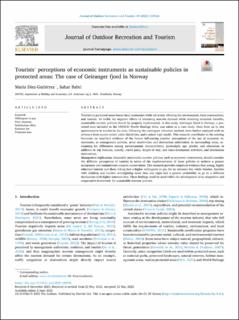| dc.description.abstract | Tourism in protected areas boosts local economies while adversely affecting the environment, local communities, and tourists. To tackle the negative effects of increasing tourism demand while retaining economic benefits, sustainable tourism policies should be properly implemented. In this study, Geiranger Fjord in Norway, a protected area included in the UNESCO World Heritage Sites, was taken as a case study. Data from an in situ questionnaire to tourists in the area, following the contingent valuation method, were further analysed with an ordinary least square model, price elasticities, and a mixed logit model. This research contributes to the existing literature on empirical evidence of the factors influencing tourists' perceptions of the use of economic instruments, as management policies, price sensitivities and destination substitution to surrounding areas, accounting for differences among socioeconomic characteristics, particularly age, gender, and education; in addition to trip features, namely, travel party, length of stay, and intra-destination activities; and destination motivations.
Management implications
Successful sustainable tourism policies, such as economic instruments, should consider the different perceptions of tourists in terms of the implementation of these policies to achieve a greater acceptance and commitment towards conservation. This research provides empirical evidence that young, highly educated tourists and those hiking had a higher willingness to pay for an entrance fee; while females, families with children and tourists overnighting more than one night had a greater probability to go to a different destination with higher entrance fees. These findings could be used within the development of an adaptative and cooperative framework for sustainable tourism policies. | en_US |

